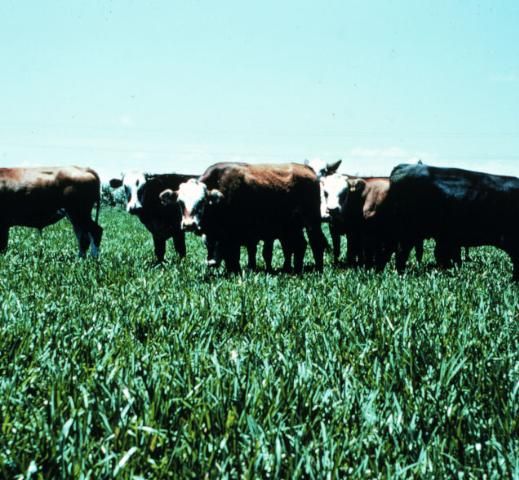The organic soils in south Florida are located south of Lake Okeechobee and encompass about 700,000 acres. The area, also known as the Everglades Agricultural Area (EAA), is primarily under agricultural production of sugarcane, vegetables, row crops, rice, and sod. In the past, the combination of potentially high forage yields on the fertile organic soils and the long grazing season were the basis for one of the highest concentrations of beef cattle and a viable beef cattle industry in Florida. Presently most livestock operations on EAA are small noncommercial herds on improved and unimproved pastures comprising less than 1% of the EAA.
St. Augustinegrass (Stenotaphrum secundatum) and limpograss (Hemarthria altissima) are the two perennial forage grasses recommended for organic soils in south Florida.
St. Augustinegrass
The 'Roselawn' variety of St. Augustinegrass was evaluated at the Everglades Experiment Station, now the Everglades Research and Education Center, and released in 1944. It produces significantly greater forage mass than all other varieties of St. Augustinegrass. St. Augustinegrass has large, flat stems and broad, coarse leaves. It spreads by long, aboveground runners or stolons. It has characteristically long internodes that grow close to the ground, and it produces top growth that contains 90%–95% leafy tissue, regardless of maturity.
St. Augustinegrass grows well on mineral soils in Florida, but due to its susceptibility to chinch bugs (Blissus leucopterus), which thrive on dry, well-drained areas, it is normally not grown on mineral soils for pasture. Because this is especially adapted to moist muck soils and grows practically year long in south Florida, it is considered the most dependable pasture grass for that area. Crabgrass and goose are the most common weeds, and they are controlled by postemergence herbicides when applied according to the herbicide labels. For more information on weed control, please refer to SS-AGR-08, Weed Management in Pastures and Rangelands (https://edis.ifas.ufl.edu/wg006).
On the organic soils of south Florida, St. Augustinegrass is tolerant to frost and usually remains green throughout the year. A freeze of less than 28°F for several hours will kill the top growth, but the plant will regrow from its base.
St. Augustinegrass is very persistent and tolerates overgrazing. Annual dry matter yield may range from 7 to 8 tons under grazing conditions. Eighty percent of St. Augustinegrass growth occurs from May through October. However, moderate quantities of stockpiled green forage can be carried into the fall and early winter period. Stockpiled forage, along with energy supplementation, will provide adequate nutrition to mature cows. St. Augustinegrass grown on organic soil maintains crude protein levels of 13% and 16%, and TDN levels of 50% and 60% during the winter and summer, respectively.
Because St. Augustinegrass does not produce commercial quantities of viable seed, it is most commonly planted vegetatively with stem pieces or plugs. St. Augustinegrass should be planted in the summer months when soil moisture is adequate. Land to be established with St. Augustinegrass should be well prepared prior to planting in order to minimize weed competition. Once a St. Augustinegrass pasture is established, if weeds are present, they may require control by herbicide or mowing.
St. Augustinegrass does not make a good quality hay. It is difficult to cure it because of its leafy characteristic, especially on organic soils, which are generally moist or wet when St. Augustinegrass produces its highest forage yields.
St. Augustinegrass is a suitable forage for cow-calf production because of its persistence, high yields, and relatively uniform quality throughout the year. St. Augustinegrass will stock two to three yearling steers per acre throughout the year with average gains of about one pound per steer daily, or 750–1,100 pounds per acre without supplementation. Daily stocking would vary from a high of about four steers per acre in July and August to a low of about three yearlings per acres in January. With this stocking rate, and five pounds of straight millrun blackstrap molasses supplement per cow daily from December through March, an 80%–90% weaned calf crop and 500–550 pound calf weaning weights are usually obtained.

Credit: C. G. Chambliss, UF/IFAS

Credit: C. G. Chambliss, UF/IFAS
Limpograss
Floralta limpograss is currently the commonly grown variety in Florida. It is the most persistent limpograss under grazing and is best adapted to wet soils. Floralta is highly digestible, but the accumulated growth is low in protein. More information on limpograss may be obtained from Sollenberger et al. (2006).
There are no forage production or animal grazing data available for Floralta grown on organic soils. Pastures and cattle would be managed similarly to that prescribed for mineral soils, as described in EDIS document SS-AGR-320 (Limpograss [Hemarthria altissima] Overview and Management; https://edis.ifas.ufl.edu/ag330), and higher dry matter yields are more likely on organic soils than is currently obtained on mineral soils. Stocking rates for Floralta limpograss on organic soils would be similar to those of St. Augustinegrass discussed above.
Selected References for Additional Information
Haines, C. E., H. L. Chapman, Jr., R. J. Allen, Jr., and R. W. Kidder. 1965. Roselawn St. Augustinegrass as a Perennial Pasture Forage for Organic Soils of South Florida. Fla. Agri. Expt. Sta. Bul. 689.
Newman, Y., J. Vendramini, L. E. Sollenberger, and K. Quesenberry. 2009. Limpograss (Hemarthria altissima): Overview and Management. SS-AGR-320. Gainesville: University of Florida Institute of Food and Agricultural Sciences. https://edis.ifas.ufl.edu/ag330
Pate, F. M., R. J. Allen, Jr., and J. R. Crockett. 1980. Fertilization of Roselawn St. Augustinegrass Pasture on Organic Soil. Fla. Agri. Expt. Sta. Bul. 811.
Pate, F. M., and W. E. Kunkle. 1989. Molasses-Based Feeds and Their Use as Supplements for Brood Cows. Fla. Agri. Expt. Sta. Circ. S-365.
Quesenberry, K.H., and Q.R. Ocumpaugh. 1980. "Crude protein, IVOMD, and yield of stockpiled limpograss." Agron. J. 72:1021–1024.
Ruelke, O.C., K.H. Quesenberry, and W.R. Ocumpaugh. 1978. "Planting techniques effects on establishment, ground cover, production and digestion of Hemarthria altissima (Poir) Stpf et C.E. Hubb." Proc. Soil Crops Sci. Soc. FL. 38: 40–42.